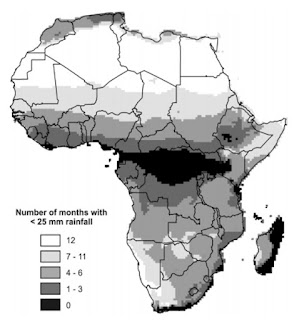Northern Africa is one of the hottest and driest places on
the planet with very low rainfall levels. The Middle East and North Africa Region (MENA) is the most water scarce area worldwide. This brings great
problems in terms of water shortages for both domestic use and farming uses. In West Africa and North Africa (WANA), 75% of water consumption is for agricultural uses. This means that the agricultural sector is more greatly
affected with fluctuations in water resources and therefore requires better
water management than other regions of Africa. By looking into the different
factors affecting North Africa, it will be possible to better understand the water
difficulties facing this region and see what farmers are doing to combat these
effects. This may be particularly important for other areas that are not
currently water scarce but will become so in the future due to climate change.
First, we begin with one of the key issues surrounding water
facing North Africa – climate. North Africa is a naturally hot and dry region
that is prone to droughts. Around 85% of MENA is desert and climate change is having a profound effect on this region. Much of the rainfall in North
Africa therefore occurs in the winter season and it is dry during the summer season. As can be seen by the map below (Figure 1), the dry season is very
long lasting in Northern Africa, lasting at least 7 months in most areas and in some places the full year. This means that the growing season in these
areas is very short without irrigation techniques. Water resources are
extremely scarce in this region presently and climate change is only going to
exacerbate this. A paper by Droogers et al. (2012) on how water resources
in North Africa will change towards 2050 found that demand for water will
increase in the MENA area under all climate scenarios as a result of population
growth. This, combined with the fact that climate change will lead to more
sporadic and intense rainfall, suggests that the future for North Africa and
water resources is extremely problematic.
 |
| Figure 1: Months with less than 25mm rainfall in Africa |
One of the fall back options for areas under drought
conditions is the availability of groundwater which has built up over centuries
and recharges gradually. Under North Africa there are large stores of groundwater but there is a complication with these reserves. Figure 2 shows the depth to the groundwater stores across Africa. As can be seen, much of
the groundwater stored under North Africa is located deep underground with much
being more than 100 metres below ground level (mbgl). This is significant
because water stored deep underground is more difficult and more costly to
extract and many poor farmers would not have access to the more sophisticated
technology required to extract this deep groundwater. This exacerbates the
problems cause by droughts as farmers cannot access the stores of water under
their feet that could allow them to sustain crops longer into the dry season. As
it is clear to see, North Africa has a much more severe problem with water
shortages than any other area in Africa because of the climatic conditions and
the unavailable groundwater resources.
 |
| Figure 2: Depth to groundwater (metres below ground level) |
So what do farmers in North Africa do to counteract these
problems? Two methods of improving productivity are supplement irrigation and water harvesting. Supplemental irrigation involves the adding of small amounts of water to crops during critical growth phases in order to boost the overall yield. This can substantially increase the crop growth and only
requires water collection and storage during peak rainfall periods. However,
farmers need the knowledge of these critical growth phases to know when
irrigate their crops. The other method mentioned, water harvesting, is defined
as “the process of concentrating precipitation through runoff and storing it for beneficial use”. This can be crucial for generating enough water to
irrigate crops to the required level. In addition, farmers in Morocco are involved in projects that introduce drought resistant crops. These crops
require less water but produce the same grain yield meaning that farmers are
less vulnerable to long droughts and serious water shortages.
North Africa suffers greatly from water shortages in a
variety of ways but have developed techniques to adapt. North Africa is an
excellent example for areas that will experience longer droughts and less
rainfall in the future as a result of climate change. The approaches to water
scarcity in North Africa are relatively easy to apply to other areas of Africa
and the world and emphasise people’s ability to adapt to adversity. These
systems suggest a hopeful future for areas at risk of water scarcity in the
future.
No comments:
Post a Comment